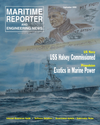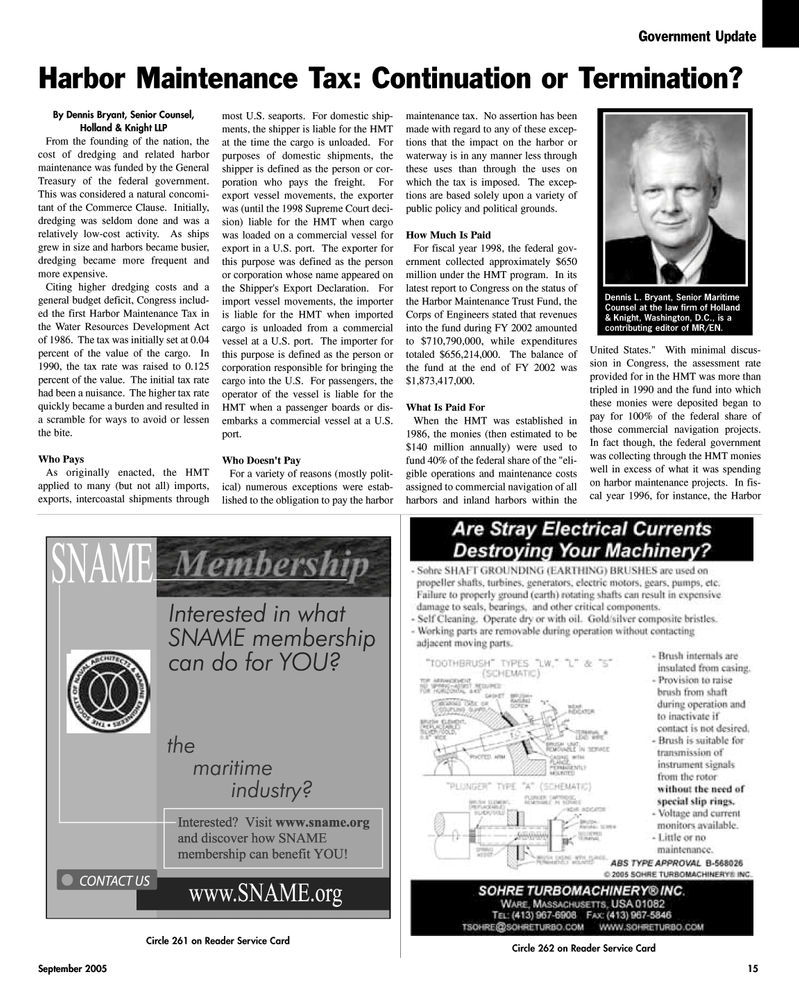
Page 15: of Maritime Reporter Magazine (September 2005)
Marine Propulsion Annual
Read this page in Pdf, Flash or Html5 edition of September 2005 Maritime Reporter Magazine
September 2005 15
Circle 261 on Reader Service Card
Circle 262 on Reader Service Card
By Dennis Bryant, Senior Counsel,
Holland & Knight LLP
From the founding of the nation, the cost of dredging and related harbor maintenance was funded by the General
Treasury of the federal government.
This was considered a natural concomi- tant of the Commerce Clause. Initially, dredging was seldom done and was a relatively low-cost activity. As ships grew in size and harbors became busier, dredging became more frequent and more expensive.
Citing higher dredging costs and a general budget deficit, Congress includ- ed the first Harbor Maintenance Tax in the Water Resources Development Act of 1986. The tax was initially set at 0.04 percent of the value of the cargo. In 1990, the tax rate was raised to 0.125 percent of the value. The initial tax rate had been a nuisance. The higher tax rate quickly became a burden and resulted in a scramble for ways to avoid or lessen the bite.
Who Pays
As originally enacted, the HMT applied to many (but not all) imports, exports, intercoastal shipments through most U.S. seaports. For domestic ship- ments, the shipper is liable for the HMT at the time the cargo is unloaded. For purposes of domestic shipments, the shipper is defined as the person or cor- poration who pays the freight. For export vessel movements, the exporter was (until the 1998 Supreme Court deci- sion) liable for the HMT when cargo was loaded on a commercial vessel for export in a U.S. port. The exporter for this purpose was defined as the person or corporation whose name appeared on the Shipper's Export Declaration. For import vessel movements, the importer is liable for the HMT when imported cargo is unloaded from a commercial vessel at a U.S. port. The importer for this purpose is defined as the person or corporation responsible for bringing the cargo into the U.S. For passengers, the operator of the vessel is liable for the
HMT when a passenger boards or dis- embarks a commercial vessel at a U.S. port.
Who Doesn't Pay
For a variety of reasons (mostly polit- ical) numerous exceptions were estab- lished to the obligation to pay the harbor maintenance tax. No assertion has been made with regard to any of these excep- tions that the impact on the harbor or waterway is in any manner less through these uses than through the uses on which the tax is imposed. The excep- tions are based solely upon a variety of public policy and political grounds.
How Much Is Paid
For fiscal year 1998, the federal gov- ernment collected approximately $650 million under the HMT program. In its latest report to Congress on the status of the Harbor Maintenance Trust Fund, the
Corps of Engineers stated that revenues into the fund during FY 2002 amounted to $710,790,000, while expenditures totaled $656,214,000. The balance of the fund at the end of FY 2002 was $1,873,417,000.
What Is Paid For
When the HMT was established in 1986, the monies (then estimated to be $140 million annually) were used to fund 40% of the federal share of the "eli- gible operations and maintenance costs assigned to commercial navigation of all harbors and inland harbors within the
United States." With minimal discus- sion in Congress, the assessment rate provided for in the HMT was more than tripled in 1990 and the fund into which these monies were deposited began to pay for 100% of the federal share of those commercial navigation projects.
In fact though, the federal government was collecting through the HMT monies well in excess of what it was spending on harbor maintenance projects. In fis- cal year 1996, for instance, the Harbor
Dennis L. Bryant, Senior Maritime
Counsel at the law firm of Holland & Knight, Washington, D.C., is a contributing editor of MR/EN.
Harbor Maintenance Tax: Continuation or Termination?
Government Update
MR SEPTEMBER 2005 #2 (9-16).qxd 9/1/2005 11:14 AM Page 15

 14
14

 16
16
